
The Noctuidae, commonly known as owlet moths, cutworms or armyworms, are a family of moths. They are considered the most controversial family in the superfamily Noctuoidea because many of the clades are constantly changing, along with the other families of the Noctuoidea. It was considered the largest family in Lepidoptera for a long time, but after regrouping Lymantriinae, Catocalinae and Calpinae within the family Erebidae, the latter holds this title now. Currently, Noctuidae is the second largest family in Noctuoidea, with about 1,089 genera and 11,772 species. This classification is still contingent, as more changes continue to appear between Noctuidae and Erebidae.
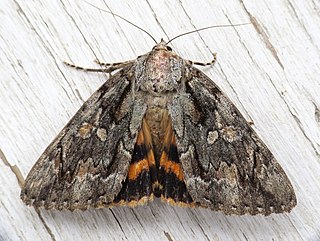
Catocala neogama, the bride, is an moth in the family Erebidae first described by James Edward Smith in 1797. It is found in North America east of the Rocky Mountains, from Maine and Quebec south to northern Florida and west to South Dakota, New Mexico, and into Arizona and Texas. Its westernmost population from the semiarid Colorado Plateau region is rather distinct and was once considered a separate species, but is now regarded as a well-marked subspecies C. n. euphemia.
Hypocoena basistriga is a species of moth of the family Noctuidae first described by James Halliday McDunnough in 1933. It is found from Newfoundland and Labrador west to British Columbia and Yukon. This species of moth is found to frequent mesic areas including the edges of aspen bluffs and hayfields, old fields, meadows, etc.

Raphia frater, the brother moth or simply the brother, is a moth of the family Noctuidae. It is found from Nova Scotia west, across the forested regions of Canada to British Columbia, south to Mississippi in the east. The southern limits in the west are uncertain due to confusion with several closely related species or forms.
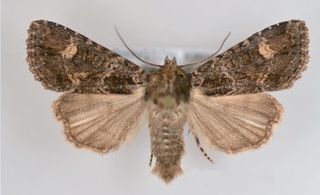
Aseptis binotata, the rusty shoulder knot moth, is a moth of the family Noctuidae. The species was first described by Francis Walker in 1865. It is found widespread in western North America, west of south-central Alberta, Wyoming, and Nebraska. Along the Pacific Coast it occurs from northern Mexico to south-central British Columbia. It can be found from sea level to altitudes over 2000 meters in a variety of habitats from dense forest to shrub desert.

Mesogona olivata is a moth of the family Noctuidae. It is found from southern coastal and interior British Columbia south through California, Colorado and Texas. It most likely also occurs in northern Mexico.
The Boston dart or drab cutworm is a moth of the family Noctuidae. It is found from Ontario and Maine to North Carolina, west to Missouri, north to Michigan. It has also been recorded from Florida, California and South Dakota.
The fawn brown dart is a moth of the family Noctuidae. It is found in southern Canada and the northern United States from southern Quebec and eastern Massachusetts west to British Columbia and southern Washington. In the Rocky Mountain region it occurs as far south as northern New Mexico, north-eastern Arizona and central Idaho. It is listed as a species of special concern in Connecticut.
Diarsia jucunda, the smaller pinkish dart, is a moth of the family Noctuidae. It is found from Newfoundland and central Ontario, west to northern Michigan and Wisconsin, south to Ohio. In the Appalachians it is found as far south as North Carolina. It has been recently recorded from Tennessee.

Diarsia rubifera, the red dart, is a moth of the family Noctuidae. It is found from coast to coast and from central and southern Canada and the northern United States. In the east it occurs as far south as western North Carolina, and in the west it has been recorded from south-western Montana and south-western Colorado. It has been recently recorded from Tennessee.

Xestia smithii, or Smith's dart, is a moth of the family Noctuidae. The species was first described by Pieter Cornelius Tobias Snellen in 1896. It is found across northern North America from Newfoundland to Alaska. In the eastern United States it occurs from Maine to Virginia and south along the Appalachians to North Carolina. In the west it is found in the Black Hills in western South Dakota and north-eastern Wyoming, in the Rocky Mountains from Montana to New Mexico, south-eastern Arizona, and from Washington to east central California. It has recently been recorded from Tennessee.
Polychrysia morigera, the disjunct looper, is a moth of the family Noctuidae. The species was first described by Henry Edwards in 1886. In the east of North America, it is found in the Mississippi, Missouri, and Ohio river valleys from Pennsylvania to Tennessee. In the Rocky Mountains it is found from Montana to Colorado and on the west coast it occurs from Oregon to northern California. It is the rarest of the North American Plusiinae species.
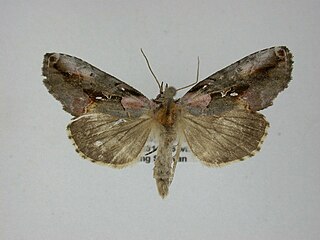
Eosphoropteryx thyatyroides, the pink-patched looper moth or pink-tinted beauty, is a moth of the family Noctuidae. The species was first described by Achille Guenée in 1852. In North America it is found from Nova Scotia and northern Ontario south to Minnesota, Michigan, Ohio and along the Appalachians from Maine to eastern Tennessee and western North Carolina; and to the west, it occurs from central Alberta and southern British Columbia, south in the Cascades to southern Oregon, and in the Rocky Mountains to northern Idaho.

Apamea rubrirena is a moth of the family Noctuidae.

Lasionycta secedens is a moth of the family Noctuidae. It has a Holarctic distribution. North American populations are distributed from Labrador, northern Manitoba, and Alaska, southward to northern Maine, northern Minnesota, and south-central British Columbia. Subspecies bohemani occurs in northern Eurasia, Alaska and Yukon.

Lasionycta phaea is a moth of the family Noctuidae. It is an arctic species and has been collected from Baffin Island in north-eastern Canada to the central Brooks Range in northern Alaska and southward along the west coast of Hudson Bay to Arviat, Nunavut.
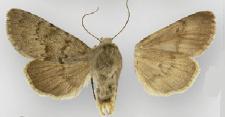
Lasionycta promulsa is a moth of the family Noctuidae. It occurs from Rampart House in northern Yukon to south-western British Columbia in the west and southern New Mexico in the Rocky Mountains.
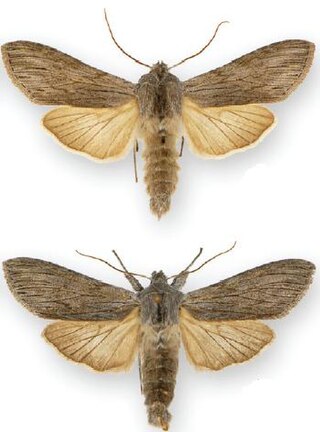
Cucullia intermedia, the dusky hooded owlet, intermediate cucullia, goldenrod cutworm or intermediate hooded owlet, is a moth of the family Noctuidae. The species was first described by Adolph Speyer in 1870. It is found from coast to coast across southern Canada and the northern United States, south in the west to California and to Pennsylvania in the east. In the Rocky Mountains it is found south to the White Mountains in east-central Arizona and occurs commonly in Utah, Colorado and north-eastern Nevada.

Blepharita amica is a moth of the family Noctuidae. It is found from northern Europe to the Russian plain, the Ural, Siberia, the Amur Oblast, Primorye Region and Kazakhstan. It has also been recorded from the Korean Peninsula, Japan and north-eastern China.

Protorthodes incincta, the banded Quaker moth, is a moth in the family Noctuidae. It is found in North America, where it has been recorded in the western Great Plains and dry open forests of the Rocky Mountain region, with range extensions into the Great Basin, the American Southwest, and eastward in relict prairie areas into the Great Lakes region.












